What (De)Motivates Forest Users’ Participation in Co-Management? Evidence from Nepal
Abstract
1. Introduction
1.1. Co-Management in Natural Resources
1.2. Motivational Drivers of Participation
1.3. Community-Based Forest Management in Nepal
2. Materials and Methods
2.1. Study Area
2.2. Data Collection
3. Results
3.1. Decision-Making and Monitoring Structure
Case of Decision Making in Timber Harvesting
3.2. Motivational Drivers of Participation in Co-Management
3.2.1. Economic Motivation
3.2.2. Social Motivation
3.2.3. Ecological Motivation
4. Discussion
5. Conclusions
Author Contributions
Funding
Acknowledgments
Conflicts of Interest
References
- Agrawal, A.; Gibson, C.C. Enchantment and disenchantment: The role of community in natural resource conservation. World Dev. 1999, 27, 629–649. [Google Scholar] [CrossRef]
- Brockington, D.; Wilkie, D. Protected areas and poverty. Philos. Trans. R. Soc. B Biol. Sci. 2015, 370, 20140271. [Google Scholar] [CrossRef] [PubMed]
- Kimengsi, J.N.; Balgah, R.A. Repositioning Local Institutions in Natural Resource Management: Perspectives from Sub-Saharan Africa. Schmollers Jahrb. J. Contextual Econ. 2017, 137, 149–172. [Google Scholar] [CrossRef]
- Jagger, P.; Sellers, S.; Kittner, N.; Das, I.; Bush, G.K. Looking for Medium-term Conservation and Development Impacts of Community Management Agreements in Uganda’s Rwenzori Mountains National Park. Ecol. Econ. 2018, 152, 199–206. [Google Scholar] [CrossRef]
- Chhotary, V.; Stoker, G. Governance Theory: A Cross-Disciplinary Approach; Palgrave Macmillan: Basingstoke, UK; New York, NY, USA, 2009; pp. 1–15. [Google Scholar]
- Mishra, H.R. Balancing human needs and conservation in Nepal’s Royal Chitwan Park. Ambio 1982, 11, 246–251. [Google Scholar]
- Hough, J. Michiru Mountain Conservation Area: Integrating conservation with human needs. In Resident People and National Parks: Social Dilemmas and Strategies in International Conservation; University of Arizona Press: Arizona, AZ, USA,, 1991. [Google Scholar]
- Rao, M.; Rabinowitz, A.; Khaing, S.T. Status review of the protected-area system in Myanmar, with recommendations for conservation planning. Conserv. Biol. 2002, 2, 360–368. [Google Scholar] [CrossRef]
- Haller, T.; Acciaioli, G.; Rist, S. Constitutionality: Conditions for crafting local ownership of institution-building processes. Soc. Nat. Resour. 2016, 29, 68–87. [Google Scholar] [CrossRef]
- Terborgh, J.; van Schaik, C.; Davenport, L.; Rao, M. (Eds.) Making Parks Work: Strategies for Preserving Tropical Nature; Island Press: Washington, DC, USA, 2002. [Google Scholar]
- Ribot, J.C. Decentralization, participation, and accountability in Sahelian forestry legal instruments of political-administrative control. Africa 1999, 69, 23–65. [Google Scholar] [CrossRef]
- Ribot, J.C. Democratic decentralization of natural resources. In Beyond Structural Adjustment the Institutional Context of African Development; Palgrave: Basingstoke, UK, 2003; pp. 159–182. [Google Scholar]
- Kimengsi, J.N.; Ngala, M.P. Revisiting participatory forest management and community livelihoods in the Kilum-Ijim Montane forest landscape of Cameroon. Int. J. Glob. Sustain. 2018, 2, 39–55. [Google Scholar] [CrossRef]
- Lund, J.F.; Rutt, R.L.; Ribot, J. Trends in research on forestry decentralization policies. Curr. Opin. Environ. Sustain. 2018, 32, 17–22. [Google Scholar] [CrossRef]
- Borrini-Feyerabend, G.; Farvar, M.T.; Nguinguiri, J.C.; Ndangang, V. Co-Management of Natural Resources: Organising. In Negotiating and Learning by Doing; Kasparek Verlag: Heidelberg, Germany; GTZ and IUCN: Heidelberg, Germany, 2000. [Google Scholar]
- Armitage, D.; Marschke, M.; Plummer, R. Adaptive co-management and the paradox of learning. Glob. Environ. Chang. 2008, 18, 86–98. [Google Scholar] [CrossRef]
- Schultz, L.; Duit, A.; Folke, C. Participation, adaptive co-management, and management performance in the world network of biosphere reserves. World Dev. 2011, 39, 662–671. [Google Scholar] [CrossRef]
- Plummer, R.; Baird, J.; Dzyundzyak, A.; Armitage, D.; Bodin, Ö.; Schultz, L. Is adaptive co-management delivering? Examining relationships between collaboration, learning and outcomes in UNESCO biosphere reserves. Ecol. Econ. 2017, 140, 79–88. [Google Scholar] [CrossRef]
- Ballet, J.; Koffi, K.J.M.; Komena, K.B. Co-management of natural resources in developing countries: The importance of context. Econ. Int. 2009, 4, 53–76. [Google Scholar]
- Li, T.M.; Sabogal, M. The Will to Improve: Governmentality, Development, and the Practice of Politics. Anthropologica 2010, 52, 210. [Google Scholar]
- Meek, C.L. Forms of collaboration and social fit in wildlife management: A comparison of policy networks in Alaska. Glob. Environ. Chang. 2013, 23, 217–228. [Google Scholar] [CrossRef]
- Kimengsi, J.N.; Aung, P.S.; Pretzsch, J.; Haller, T.; Auch, E. Constitutionality and Adaptive Co-Management of Tropical Protected Areas: Reflections from Cameroon and Myanmar. Int. J. Commons 2019. in review. [Google Scholar]
- Guerbois, C.; Dufour, A.B.; Mtare, G.; Fritz, H. Insights for integrated conservation from attitudes of people toward protected areas near Hwange National Park, Zimbabwe. Conserv. Biol. 2013, 27, 844–855. [Google Scholar] [CrossRef]
- Fischer, A.; Wakjira, D.T.; Weldesemaet, Y.T.; Ashenafi, Z.T. On the interplay of actors in the co-management of natural resources—A dynamic perspective. World Dev. 2014, 64, 158–168. [Google Scholar] [CrossRef]
- Carlsson, L.; Berkes, F. Co-management: Concepts and methodological implications. J. Environ. Manag. 2005, 75, 65–76. [Google Scholar] [CrossRef]
- Arnstein, S.R. A ladder of citizen participation. J. Am. Inst. Plan. 1969, 35, 216–224. [Google Scholar] [CrossRef]
- Agarwal, B. Participatory exclusions, community forestry, and gender: An analysis for South Asia and a conceptual framework. World Dev. 2001, 29, 1623–1648. [Google Scholar] [CrossRef]
- Kimengsi, J.N.; Balgah, R.A.; Gwan, S.A. Enhancing Community Participation for Rural Development in Central Ejagham of Cameroon: Challenges and Prospects. Int. J. Community Dev. 2016, 4, 20–32. [Google Scholar] [CrossRef]
- Evans, K.; Flores, S.; Larson, A.M.; Marchena, R.; Müller, P.; Pikitle, A. Challenges for women’s participation in communal forests: Experience from Nicaragua’s indigenous territories. Women’s Stud. Int. Forum 2017, 65, 37–46. [Google Scholar] [CrossRef]
- Fals Borda, O.; Rahman, M.A. Action and Knowledge: Breaking the Monopoly with Participatory Action-Research. Apex Press: New York, NY, USA, 1991. [Google Scholar]
- Barnaud, C. Equité, jeux de pouvoir et légitimité: Les dilemmes d’une gestion concertée des ressources renouvelables, mise à l’épreuve d’une posture d’accompagnement critique dans deux systèmes agraires des hautes terres du Nord de la Thaïlande. PhD. Thesis, Université de Paris-Nanterre, Nanterre, France, 2008. [Google Scholar]
- United Nations. Popular Participation in Decision Making for Development; UN Department for Economics and Social Affairs: New York, NY, USA, 1975. [Google Scholar]
- FAO. Forests and Gender Equality: Participatory Forestry. 2014. Available online: http://www.fao.org/3/a-i3880e.pdf (accessed on 18 March 2019).
- Cooke, B.; Kothari, U. Participation: The New Tyranny? Zed Books: London, UK, 2001. [Google Scholar]
- Marshall, B.K.; Jone, R.E. Citizen participation in natural resource management: Does representativeness matter? Sociol. Spectr. 2005, 25, 715–737. [Google Scholar] [CrossRef]
- Coulibaly-Lingani, P.; Savadogo, P.; Tigabu, M.; Oden, P.C. Factors influencing people’s participation in the forest management program in Burkina Faso, West Africa. For. Policy Econ. 2011, 13, 292–302. [Google Scholar] [CrossRef]
- Ranjit, Y. Determinants of People’s Participation in Forest Protection and Management: A Study in Kaski, Nepal. Econ. J. Dev. Issues 2014, 17–18, 175–186. [Google Scholar] [CrossRef]
- Islam, K.K.; Rahman, G.M.M.; Fujiwara, T.; Sato, N. People’s participation in forest conservation and livelihoods improvement: Experience from a forestry project in Bangladesh. Int. J. Biodivers. Sci. Ecosyst. Serv. Manag. 2013, 9, 30–43. [Google Scholar] [CrossRef]
- Raufirad, V.; Hunter, R.; Khalili, R.; Bagheri, S. Drivers of local people’s participation in sustainable natural resource management: A case study in central Iran. Local Environ. 2017, 22, 880–893. [Google Scholar] [CrossRef]
- Adhikari, R.B.; Baral, R.N.; Hancock, J.; Kafley, G.; Koirala, P.; Reijmerinck, J.; Shapiro, B. Regenerating Forests and Livelihoods in Nepal: A New Lease on life. Unfolding the Experience of 20 Years Poverty Alleviation through Leasehold Forestry in the Himalayas. CABI: Wallingford, UK, 2015; pp. 1–270. [Google Scholar]
- Paudel, N.S.; Bhusal, P.; Thompson, P.; Sultana, P.; Adhikary, A.; Bhandari, K. Transforming Forest Conflicts: Learning from North-South Conflicts over Community Forests in Terai Region of Nepal. J. For. Livelihood 2018, 16, 1. [Google Scholar] [CrossRef][Green Version]
- Acharya, K.P.; Oli, B.N. Impacts of community forestry in rural livelihoods: A case study form Bharkhore CF, Parbat district. Banko Janakari 2004, 14, 46–50. [Google Scholar] [CrossRef][Green Version]
- Gautam, A.P.; Shivakoti, G.P.; Webb, E.L. A review of forest policies, institutions, and changes in the resource condition in Nepal. Int. For. Rev. 2004, 6, 136–148. [Google Scholar] [CrossRef]
- Rutt, R.L.; Chhetri, B.B.K.; Pokharel, R.; Rayamajhi, S.; Tiwari, K.; Treue, T. The scientific framing of forestry decentralization in Nepal. For. Policy Econ. 2015, 60, 50–61. [Google Scholar] [CrossRef]
- Sterk, A.; Johnson, A.; Durst, P.B. Leasing Degraded Forest Land: An Innovative Way to Integrate Forest and Livestock Development in Nepal; FAO: Rome, Italy, 1998. [Google Scholar]
- Bajracharya, S.B.; Gurung, G.B.; Basnet, K. Learning from Community Participation in Conservation Area Management. J. For. Livelihood 2007, 6, 54–66. [Google Scholar]
- Bajracharya, S.B.; Furley, P.A.; Newton, A.C. Effectiveness of community involvement in delivering conservation benefits to the Annapurna Conservation Area, Nepal. Environ. Conserv. 2005, 32, 239–247. [Google Scholar] [CrossRef]
- Christensen, M.; Heilmann-Clausen, J. Forest biodiversity gradients and the human impact in Annapurna Conservation Area, Nepal. Biodivers. Conserv. 2009, 18, 2205–2221. [Google Scholar] [CrossRef]
- Chhetri, B.; Johnsen, F.; Konoshima, M.; Yoshimoto, A. Community forestry in the hills of Nepal. Determinants of user participation in forest management. For. Policy Econ. 2013, 30, 6–13. [Google Scholar] [CrossRef]
- Bajracharya, S.B.; Furley, P.A.; Newton, A.C. Impacts of Community-based Conservation on Local Communities in the Annapurna Conservation Area, Nepal. Biodivers. Conserv. 2006, 15, 2765–2786. [Google Scholar] [CrossRef]
- Ruiz-Mallén, I.; Schunko, C.; Corbera, E.; Rös, M.; Reyes-García, V. Meanings, drivers, and motivations for community-based conservation in Latin America. Ecol. Soc. 2015, 20, 33. [Google Scholar] [CrossRef]
- Zhu, T.; Krott, M.; Chen, H. Co-management implementation forested national reserves: Contradicting cases from China. For. Policy Econ. 2014, 38, 72–80. [Google Scholar] [CrossRef]
- Gutiérrez, N.L.; Hilborn, R.; Defeo, O. Leadership, social capital and incentives promote successful fisheries. Nature 2011, 470, 386–389. [Google Scholar] [CrossRef]
- De Pourcq, K.; Thomas, E.; Arts, B.; Vranckx, A.; Léon-Sicard, T.; Van Damme, P. Conflict in protected areas: Who says co-management does not work? PLoS ONE 2015, 10, e0144943. [Google Scholar] [CrossRef] [PubMed]
- Rasmussen, M.B.; French, A.; Conlon, S. Conservation Conjunctures: Contestation and Situated Consent in Peru’s Huascaran National Park. Conserv. Soc. 2019, 17, 1–14. [Google Scholar] [CrossRef]
- Zulu, L. Bringing People Back into Protected Forests in Developing Countries: Insights from Co-Management in Malawi. Sustainability 2013, 5, 1917–1943. [Google Scholar] [CrossRef]
- Gilmour, P.W. Factors and Processes Affecting Co-Management of Natural Resources. Ph.D. Thesis, The University of Melbourne, Melbourne, Australia, 2013. [Google Scholar]
- Berkes, F.; George, P.; Preston, R. Co-management: The evolution of the theory and practice of joint administration of living resources. Alternatives 1991, 18, 12–18. [Google Scholar]
- Haller, T.; Belsky, J.M.; Rist, S. The Constitutionality Approach: Conditions, Opportunities, and Challenges for Bottom-Up Institution Building. Hum. Ecol. 2018, 46, 1–2. [Google Scholar] [CrossRef]
- Akwah Neba, G.; Walters, G.; Jung, H.-Y. Examining the Supply and Demand of Effective Participation and Representation. In Global Forest Governance and Climate Change (Palgrave Studies in Natural Resource Management); Nuesiri, E.O., Ed.; Palgrave Macmillan: Cham, Switzerland, 2018. [Google Scholar]
- Silva França, C.S.; Kyei, E.O.; Aragundi, G.S.; Rutt, R.L. Making sense of conservation behaviors in Mustang, Nepal. Banko Janakari 2019, 29, 1–22. [Google Scholar]
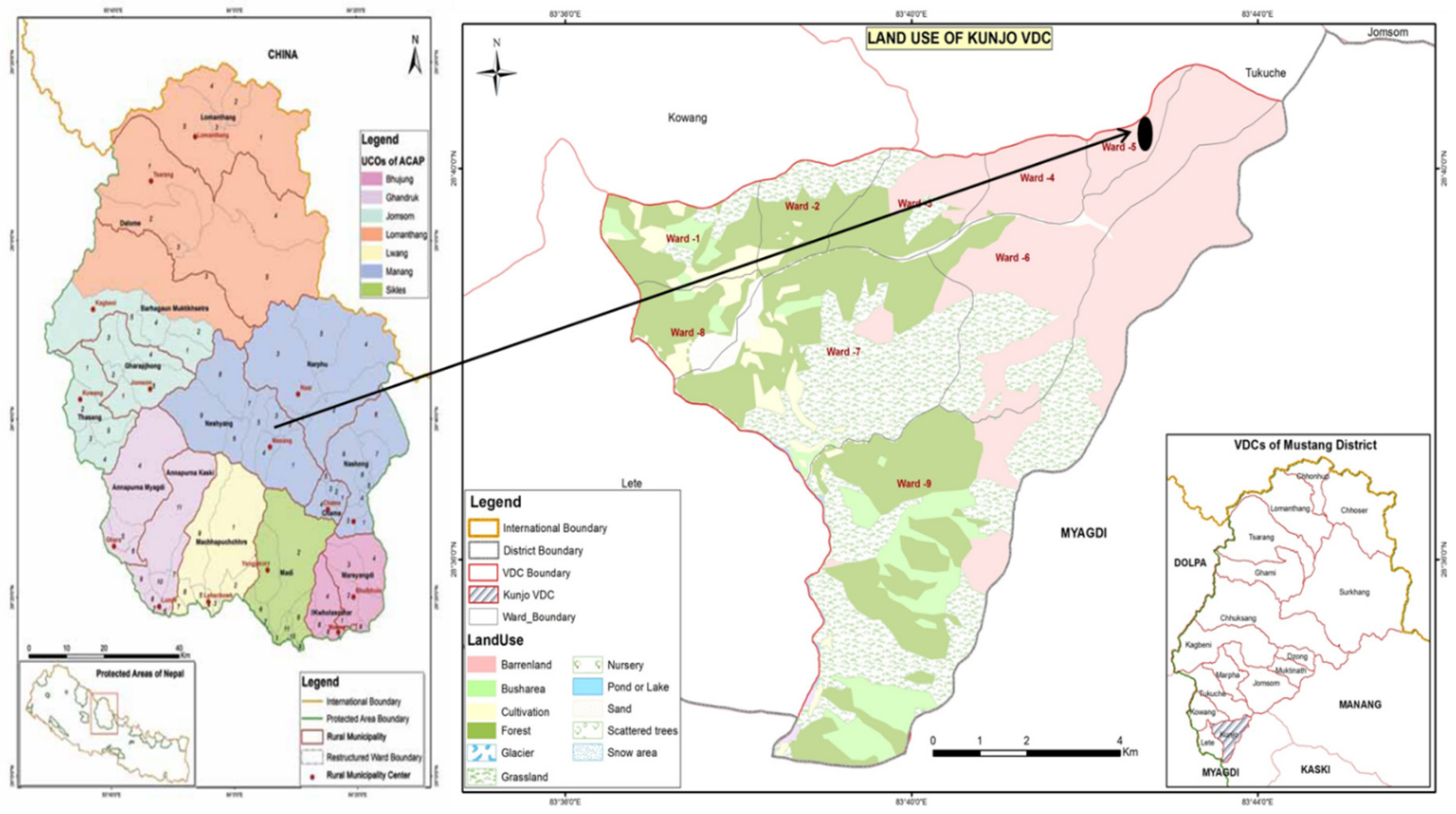
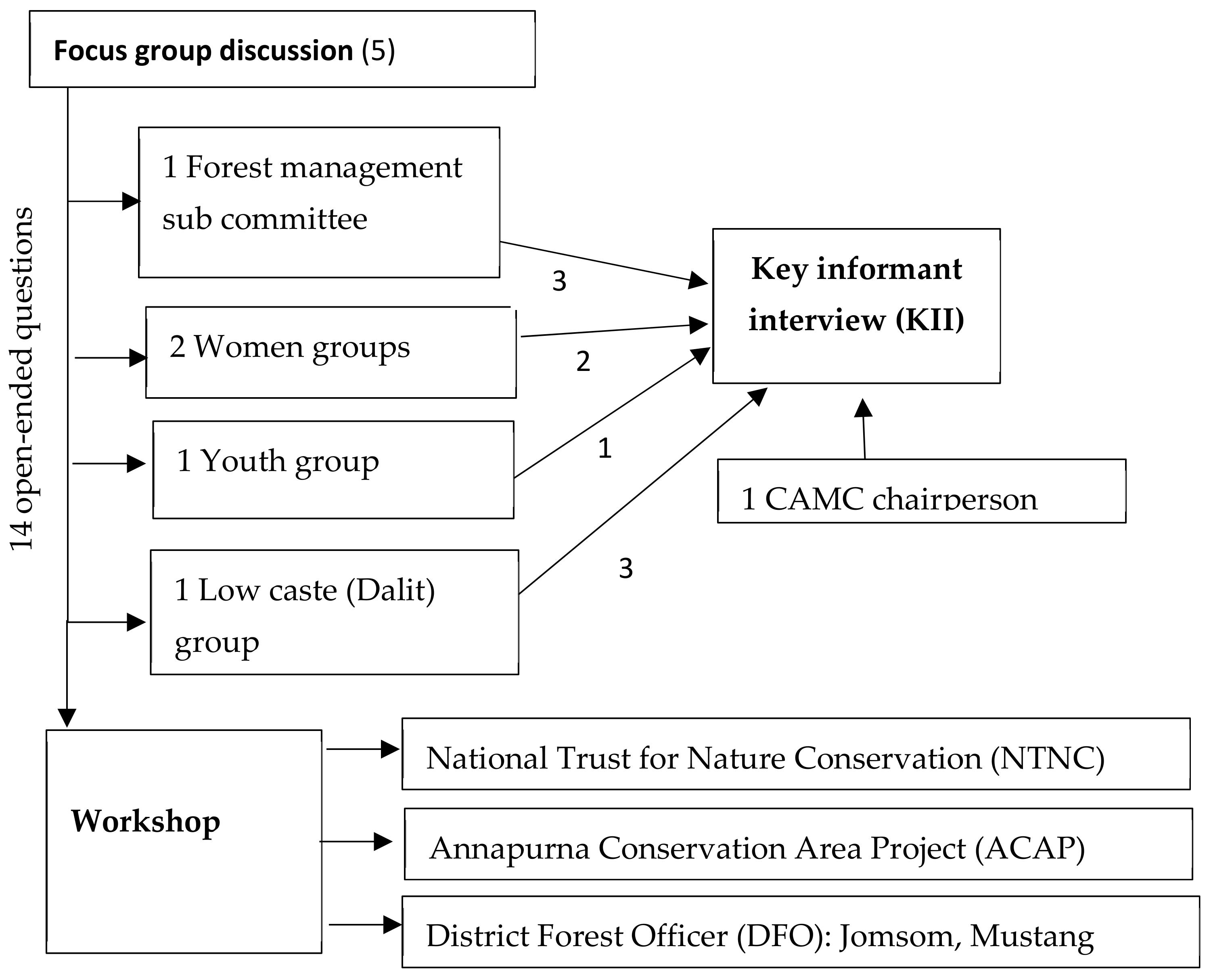
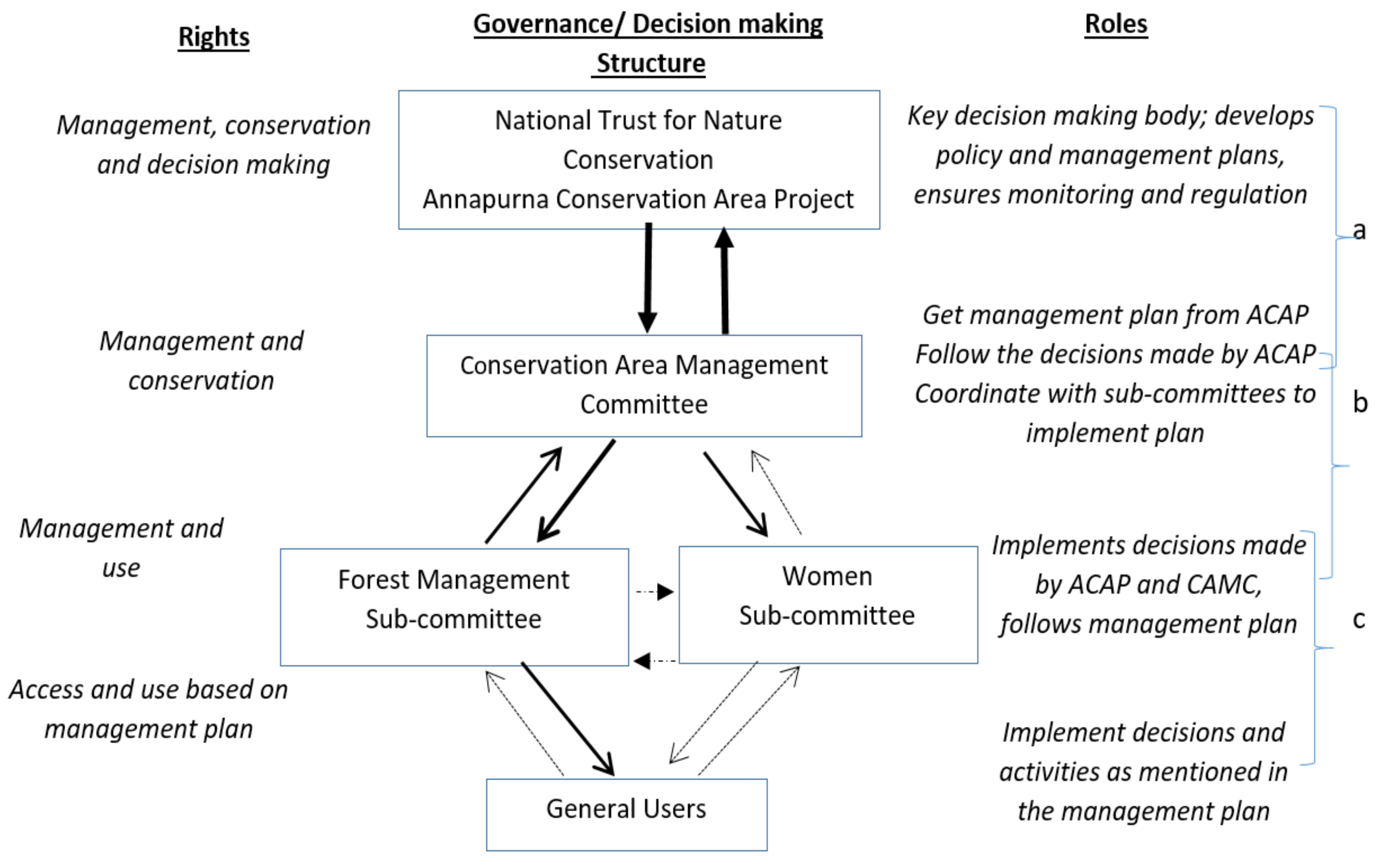
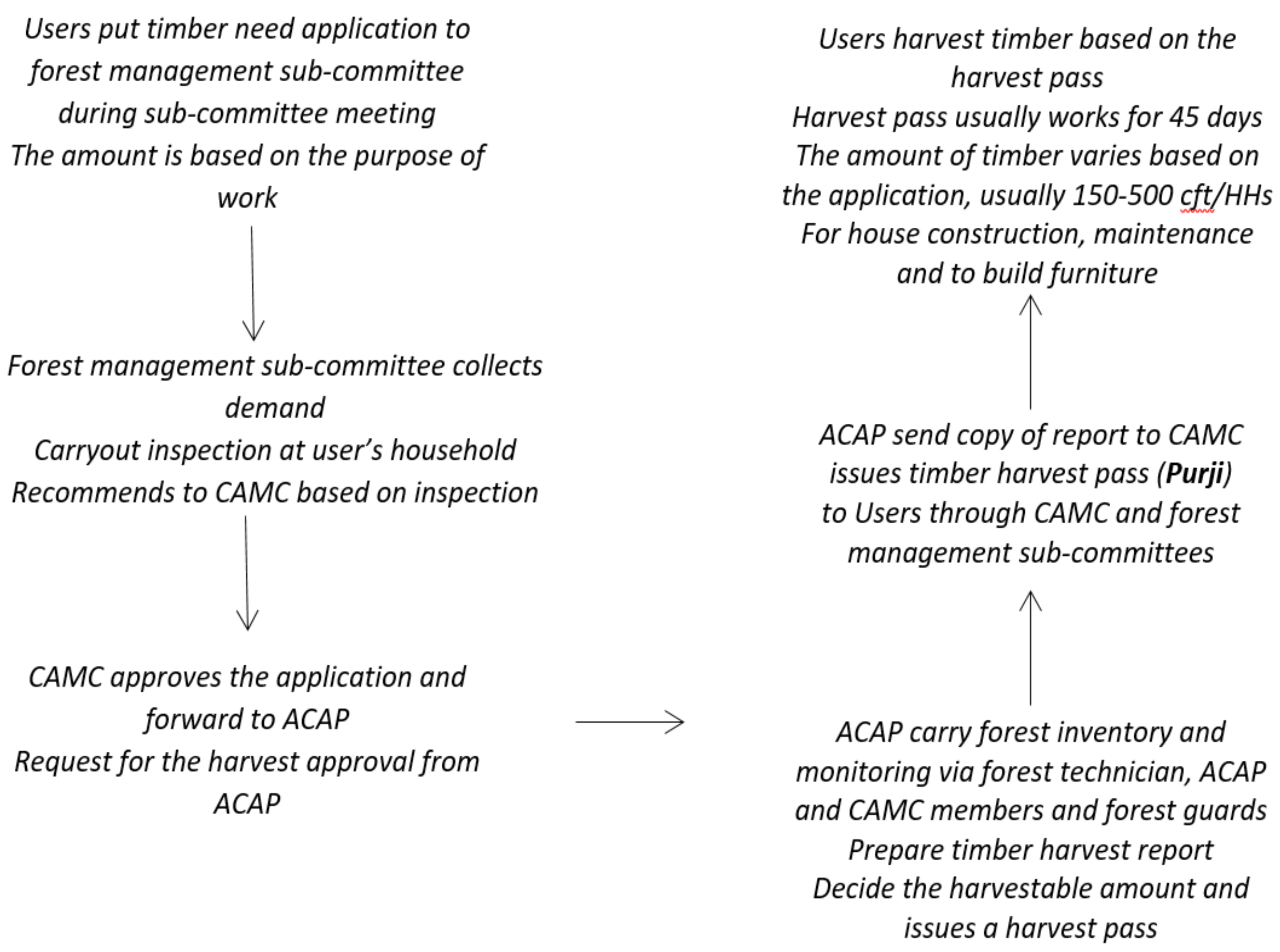
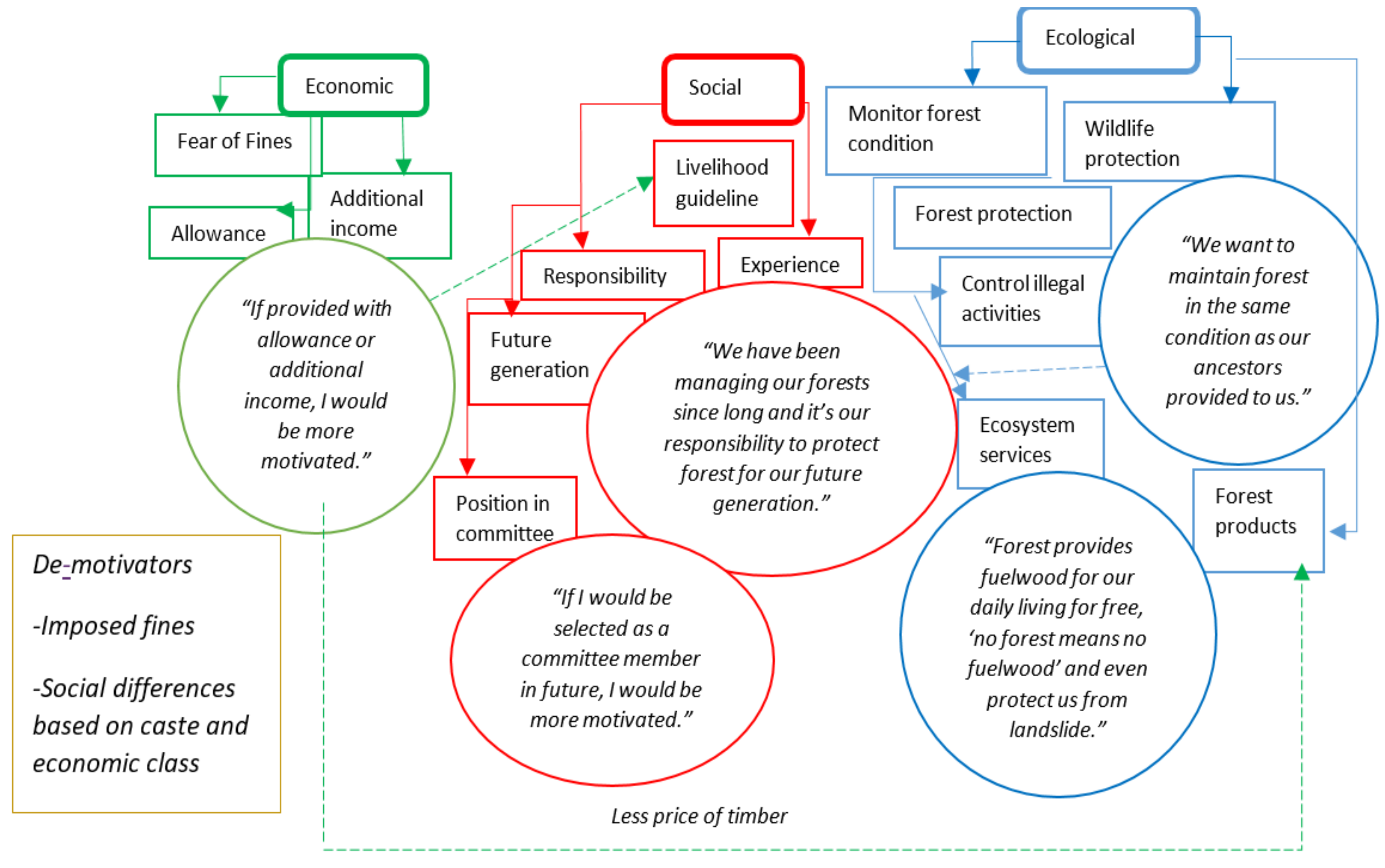
| Form of Participation | Characteristic Features |
|---|---|
| Nominal participation | Membership in the group |
| Passive participation | Being informed of decisions ex post facto; or attending meetings and listening in on decision-making, without speaking up |
| Consultative participation | Being asked an opinion in specific matters without guarantee of influencing decisions |
| Activity-specific participation | Being asked to (or volunteering to) undertake specific tasks |
| Active participation | Expressing opinions, whether solicited, or taking initiatives of other sorts |
| Interactive (empowering) participation | Having voice and influence in the group decision-making |
| Village | Total no. of HHs | Average HH Size | Distance from the Forest (km) | No. of FMSCs and WGSCs | Effective Year | Leadership Gender |
|---|---|---|---|---|---|---|
| Kunjo | 21 | 4 | 1.5 | FMSC–1 WGSC–1 | 2014–2019 | FMSC: 11 members, 9 males (1 Dalit) and 2 females (Dalits) WGSC: All females |
| Parshyang | 33 | 4 | 1 | |||
| Titi | 13 | 5 | 1 | FMSC–1 WGSC–1 | 2014–2019 | FMSC: 18 members, 12 males (5 Dalits) and 6 females (6 Dalits) WGSC: All females |
| Taglung | 19 | 3 | 2–3 | FMSC–1 WGSC–1 | 2014–2019 | FMSC: 11 members, 9 males (1 Dalit) and 2 females WGSC: All females |
| Chhayo | 28 | 5 | 2–3 | FMSC–1 WGSC–1 | 2014–2019 | FMSC: 9 members, 7 males (4 Dalits) and 2 females (2 Dalits) WGSC: All females |
| Forest Products | Annual Need per HH | Amount (per Local Market) |
|---|---|---|
| Timber | 40 cft | NRs 200/cft ** |
| Fuelwood | 50 Bhari * | NRs 250/Bhari |
| Fodder | 18 Bhari | - |
| Bamboo (Nigalo) | 30 Bhari | NRs 50/Bhari |
| Leaf litter | 100 Bhari | - |
| NTFPs | Household use | - |
© 2019 by the authors. Licensee MDPI, Basel, Switzerland. This article is an open access article distributed under the terms and conditions of the Creative Commons Attribution (CC BY) license (http://creativecommons.org/licenses/by/4.0/).
Share and Cite
Kimengsi, J.N.; Bhusal, P.; Aryal, A.; Fernandez, M.V.B.C.; Owusu, R.; Chaudhary, A.; Nielsen, W. What (De)Motivates Forest Users’ Participation in Co-Management? Evidence from Nepal. Forests 2019, 10, 512. https://doi.org/10.3390/f10060512
Kimengsi JN, Bhusal P, Aryal A, Fernandez MVBC, Owusu R, Chaudhary A, Nielsen W. What (De)Motivates Forest Users’ Participation in Co-Management? Evidence from Nepal. Forests. 2019; 10(6):512. https://doi.org/10.3390/f10060512
Chicago/Turabian StyleKimengsi, Jude Ndzifon, Prabin Bhusal, Anisha Aryal, Maria Vio Bianca Coronel Fernandez, Raphael Owusu, Anand Chaudhary, and Wicki Nielsen. 2019. "What (De)Motivates Forest Users’ Participation in Co-Management? Evidence from Nepal" Forests 10, no. 6: 512. https://doi.org/10.3390/f10060512
APA StyleKimengsi, J. N., Bhusal, P., Aryal, A., Fernandez, M. V. B. C., Owusu, R., Chaudhary, A., & Nielsen, W. (2019). What (De)Motivates Forest Users’ Participation in Co-Management? Evidence from Nepal. Forests, 10(6), 512. https://doi.org/10.3390/f10060512





